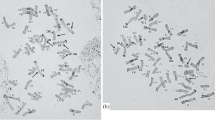Abstract
An introduction of genetic material from rye, Aegilops and Elymus into durum and common wheat by crossing the wheat species with different amphiploids, has been attempted. Meiotic studies of the hybrids demonstrated that the wheat Elymus sibiricus amphiploid contained several (two or three) genes suppressing the activity of the wheat homoeologous pairing control system. Somatic chromosome studies of the hybrids revealed that the distributions of the alien chromosomes transferred to the second hybrid generation did not correspond to random (0.5 + 0.5)2k and binomial (p + q)2k distributions. An essential amendment for gamete and zygote viability, allowing the approximation of distributions by binomial equation, is discussed. The preferential E. sibiricus chromosome transmission was observed. The first backcross was found to be a critical stage while using the Aegilops-rye amphiploids for production of wheat introgressive forms. Stabilisation of the somatic karyotype and improvement of the meiotic regularity was observed in a number of generations. The isolation of stable cytological lines in BC3 was found to be possible.
Similar content being viewed by others
References
Gupta, P.K. & G. Fedak. 1986. The inheritance of genetic variation in rye (Secale cereale) affecting homoeologous chromosome pairing in hybrids with bread wheat (Triticum aestivum). Can. J. Genet. Cytol. 28: 844-851.
Hutchinson, J., V. Chapman & T.E. Miller. 1980. Chromosome pairing at meiosis in hybrids between Aegilops and Secale species: A study by in situ hybridisation using cloned DNA. Heredity 45: 245-254.
Kerber, E.R. 1987. Resistance to leaf rust in hexaploid wheat: Lr 32, a third gene derived from Triticum tauschii. Crop. Sci. 27: 204-206.
Lenne, J.M. & D. Wood. 1991. Plant disease and use of wild germplasm. Ann. Rev. Phytopathol. 29: 35-63.
Motsny, I.I. & V.K. Simonenko. 1996. The influence of Elymus sibiricus L. genome on the diploidization system of wheat. Euphytica 91: 189-193.
Pieritz, W.J. 1966. Untersuchungen über die Ursachen der Aneuploidie bei amphidiploiden Weizen-Roggen-Bastarden und ü ber die Funktionsfähigkeit ihrer männlichen und weiblichen Gameten. Z. Pflanzenzü cht. 56: 27-69.
Semyonov, V.I., E.V. Semyonova & T.I. Vostrikova. 1985. The study of chromosome number in the F2 generation of hybrids from crossing common wheat and its some telocentric lines with perennial wheat. Genetics (USSRR) 21: 117-128. (Russian).
Sechnyak, A.L. & V.K. Simonenko. 1991a. The influence of the rye genome Rce on the homoeology pairing in Secale cereale L. hybrids with polyploid species Triticum L. and Aegilops L. Cytol. and Genet. (Kiev) 25: 20-23. (Russian).
Sechnyak, A.L. & V.K. Simonenko. 1991b. The crossability of Aegilops crassa Boiss. with Triticum aestivum L. and meiosis features in the hybrids. Nauch-techn. Bull. BSGI (Odessa) 2 (79): 10-14. (Russian).
Simonenko, L.K., L.T. Babayants & V.K. Simonenko. 1995. Development and study of Mironovskaya 808 wheat line with introgression of mildew (Erysiphe graminis) resistane genes from Agropyron elongatum, pp. 149-150. EWAC Newsletter.
Simonenko, V.K. & I.I. Motsny. 1992a. Hybridization of bread wheat with different incomplete wheat-Elymus hybrids. Nauch-techn. Bull. VSGI (Odessa) 1 (81): 14-18. (Russian).
Simonenko, V.K. & I.I. Motsny. 1992b. Hybridization results of Triticale with common persicoides wheat when using embryoculture. Ibid 2 (82): 12-19. (Russian).
Simonenko, V.K. & I.I. Motsny. 1992c. The hybridization of tetraploid wheat with wheat-Elymus amphidiploids at application of embryoculture. In: S.V. Birukof (Ed) Methods of biotechnology in agricultural plant breeding. Collected scientific paper VSGI (Odessa), pp. 17-24. (Russian).
Thompson, W.P. 1934. The causes of the cytological results obtained in a wheat species cross. Canad. J. Res. 10: 190-198.
Tzvelev, N.N. 1976. Poaceae URSS. Academia Scientiarum URSS, Leningrad.
Zhirov, E.G. & T.K. Ternovskaya. 1979. Studies on heritability of chromosomes of the D genome in progeny of wheat pentaploids. I. Analysis of backcrosses. Genetics (USSR) 15: 120- 130. (Russian).
Author information
Authors and Affiliations
Rights and permissions
About this article
Cite this article
Simonenko, V., Motsny, I., Sechnyak, A. et al. The use of wheat-alien and Aegilops-rye amphiploids for introgression of genetic material to wheat. Euphytica 100, 313–321 (1998). https://doi.org/10.1023/A:1018309802377
Issue Date:
DOI: https://doi.org/10.1023/A:1018309802377



